Reading is the home of the biscuit tin. Through ten biscuit tins in the Museum's Huntley & Palmers Collection this blog explores the history of two great Reading companies, Huntley & Palmers and Huntley, Boorne & Stevens.
The story starts in 1822 when Joseph Huntley started making biscuits in his small baker's shop on London Street in Reading. It stood on the busy London to Bath road, near the Crown coaching inn and each day biscuits were sold from a basket. The bakery quickly developed a good name with hungry coach travellers. The potential to sell biscuits further afield was soon realised and in 1832 Joseph Huntley’s younger son, also Joseph, began making tin boxes in his ironmonger's shop which stood opposite the London Street bakery. The bakery became the world famous biscuit and cake company Huntley & Palmers, and the tin shop developed into Britain's leading tin works Huntley, Boorne & Stevens.
George Palmer joined the firm in 1841. Palmer moved production in 1846 to a larger site on Kings Road in Reading. By 1898 an 'industrial army' of just over 5,000 men and women worked in a complex of factory buildings covering 24 acres on both banks of the River Kennet. It was the largest biscuit factory in the world and exported globally.
1. Ten Pound Tins
The first tins to be made were large, square, 10lb tins which Huntley & Palmers then labelled. These were made by hand and cut from standard-sized sheets of tinplate weighing 115lb. A trained box maker could make about a hundred per day and it was not long before demand outstripped supply. They also made similar square 7lb shop display tins with glass lids. The biscuits were then sold directly from the tins and the grocer would weigh out the required quantity of biscuits into a paper bag.
When Huntley & Palmers began to use the railways to transport their biscuits, they found that the square tins did not fit well into the Great Western Railway's goods carriages. So the later versions of these tins were produced with one side slightly longer than the other in order to fit in the carriages!
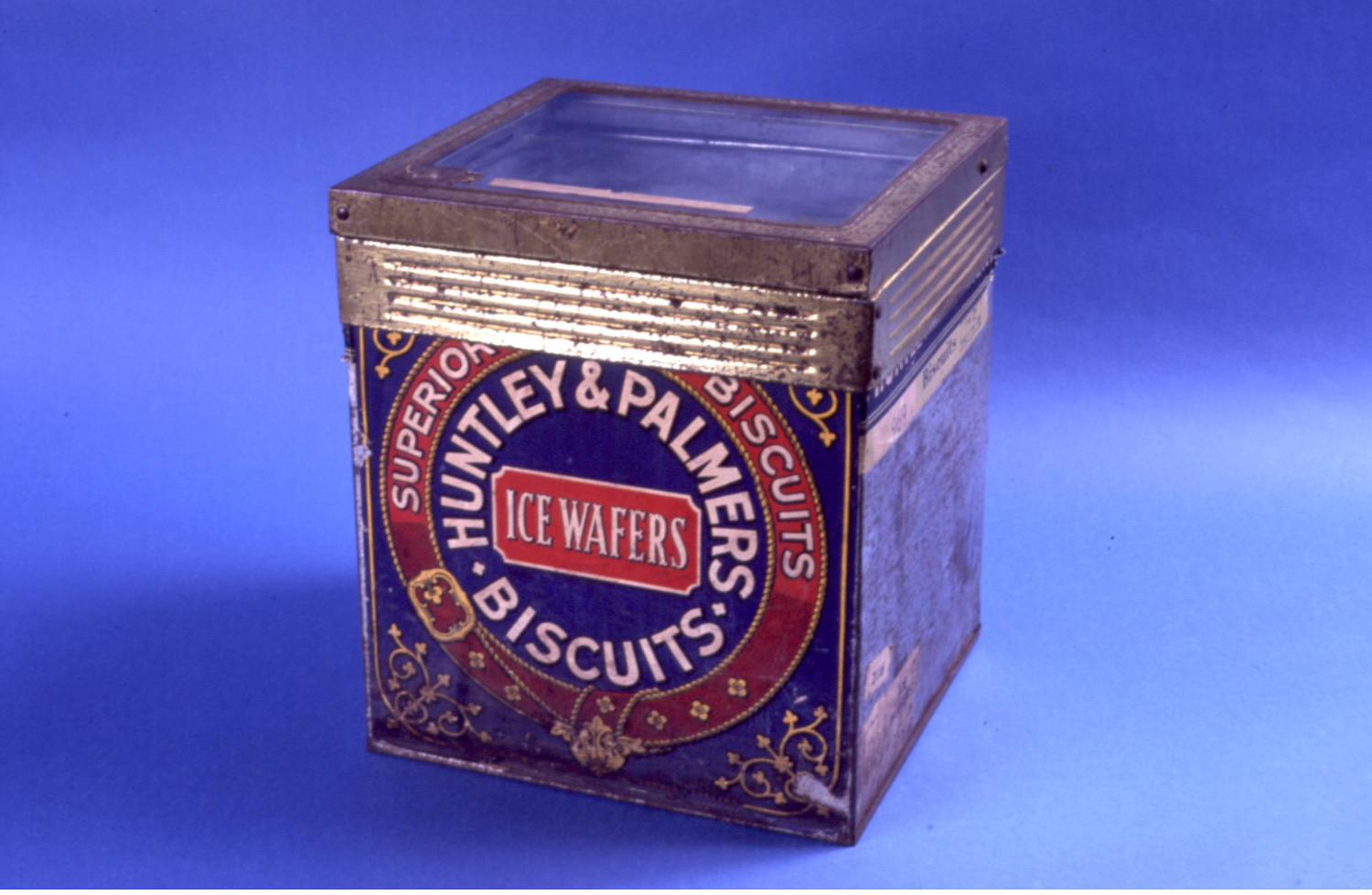
7lb shop display tin with a glass lid for Iced Wafers, 1950s. It has the company's distinctive garter and buckle logo.
2. The first decorative tin – the Ben George
Initially tin designs were printed directly onto the tin using a lithographic stone and usually involved only two colours. In the 1860s transfer printing developed whereby the image would appear on paper. This would be soaked and pressed onto the tin and the backing paper would be wiped off. The same method is still used today for children's stick-on tattooes.
The 'Ben George' may be the earliest example of a 'printed' biscuit tin. It was decorated by the transfer process, patented by Benjamin George of London, hence the name of the tin. The design was the work of the leading Victorian designer Owen Jones, who had also created Huntley & Palmers' garter and buckle trademark in 1851. This distinctive trademark was recognised throughout the world on its ten pound and shop tins.
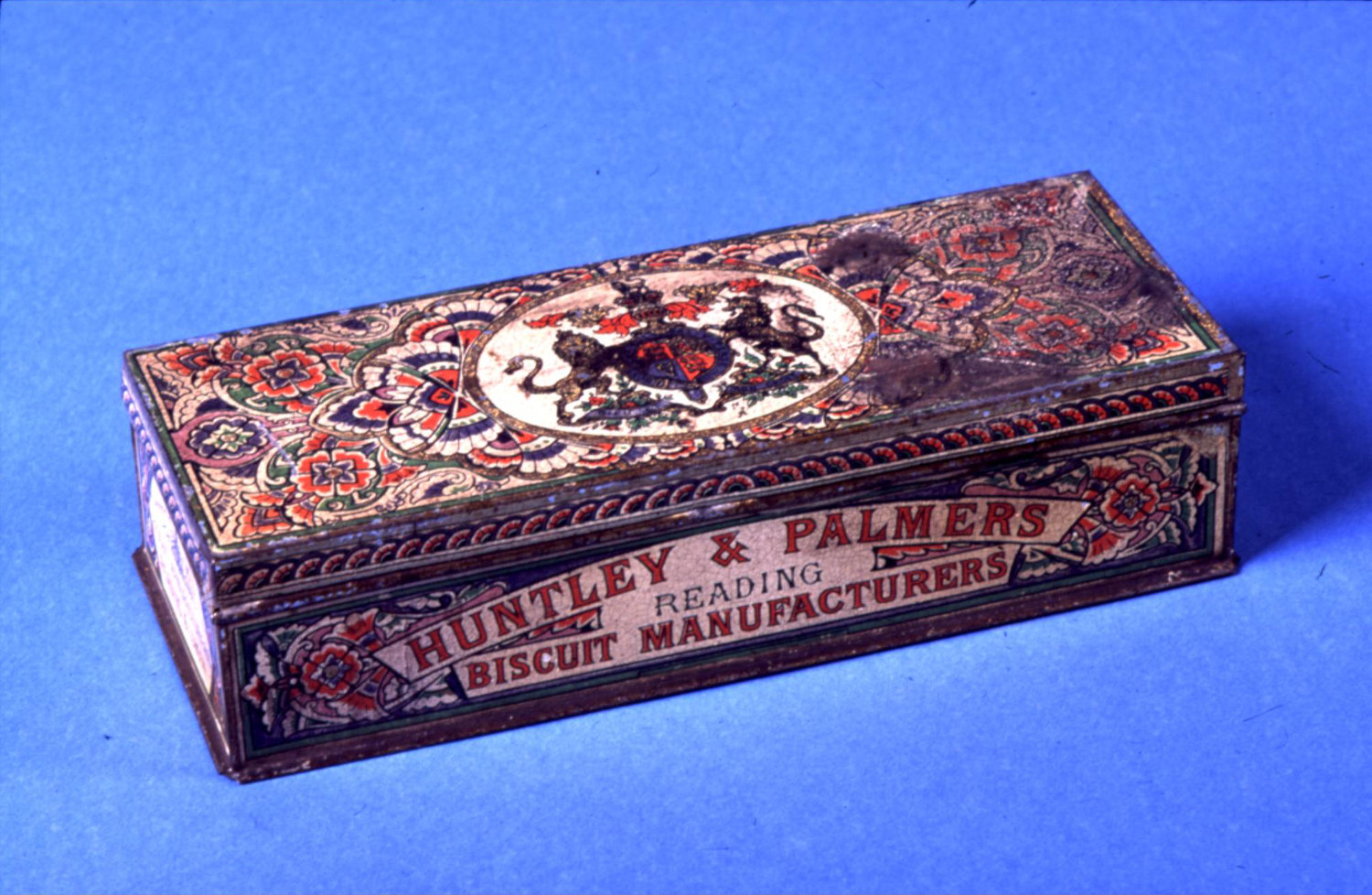
The Ben George was the first printed biscuit tin made in 1868
3. Offset lithography tins
In 1877 Huntley, Boorne & Stevens acquired the exclusive rights from Bryant & May (the match company) to the new 'offset lithography' process for printing on metal. This new technique allowed the manufacture of more complex shapes and coloured tins.
This is an early example of the offset litho method, a small tin called 'Speciality Small'. The 'Speciality' series of tins were issued by Huntley & Palmers in the 1870s. This group of early tins were of a rectangular shape and usually combined several colours in simple patterns and encorporated the royal coat of arms (Queen Victoria was one the company's royal customers).

Speciality Small Huntley & Palmers tin, 1870s
4. Books, baskets and binoculars
The early biscuit tins to be produced were in the shape of rectangular or square boxes and were decorated with simple designs or images of birds, people or places. However by the 1890s tins shaped as actual objects began to appear.
This tin in the shape of eight bound books by Sir Walter Scott is called Waverley and was issued in 1903. Huntley & Palmers produced their first book tin, Library, in 1900. This was followed in 1901 with Literature and this tin was the third in the series simulating bound books. The book tins were one of the most popular tins with customers and were produced, in ten different variations, until 1924. Between 1900 and 1924 over 650,000 book-shaped tins were issued by the company in ten different variations.
Whilst the early biscuit tins had featured the biscuit manufacturers name on the design, it became increasingly unfashionable to use such blatant advertising in the Victorian Era. From the 1880s, when the firms name was only inscribed on the base of the tin, the tins became acceptable objects to use as ornaments or as storage in the home.
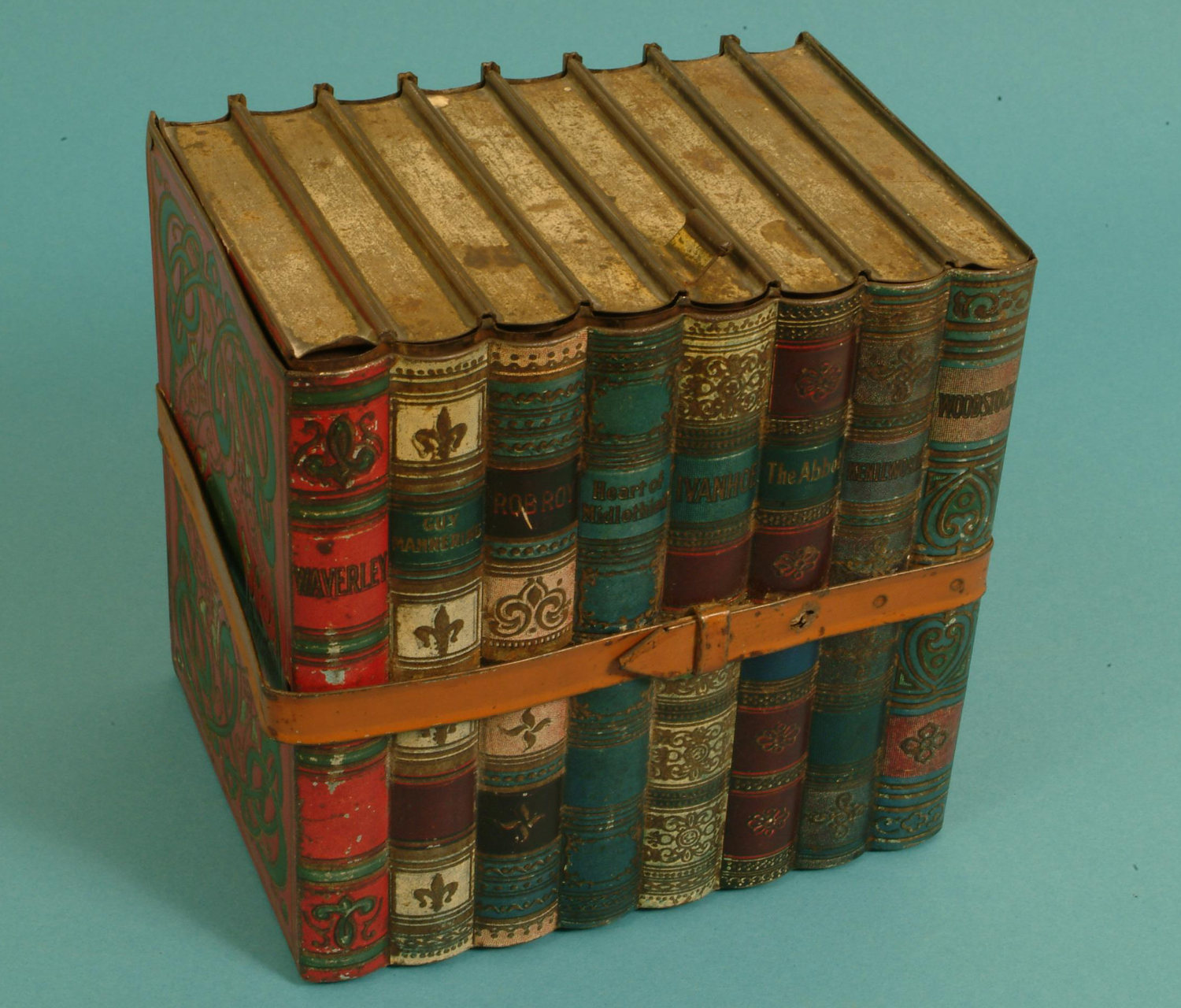
Huntley & Palmers Waverley tin, 1903
5. First World War and the home front
During the First World War the production of fancy tins decreased drastically from 518,000 in 1913 to 200,000 in 1915. Whilst this was caused in part by a lack of demand, Huntley, Boorne & Stevens were also busy manufacturing goods for the War Office including 536,000 water bottles and more than 6 million detonators.
The years 1914-1916, despite the outbreak of war, represented business as usual for the Huntley & Palmers. However from 1916 both food and labour shortages started to affect production and life in the factory. The number of women employed increased as they began to take over some of the jobs of the absent men. From 1915 Alfred Palmer agreed to make shells in the engineering department and many women were trained up to help, bringing an end to the strict segregation of sexes within the factory.
This sentry tin was first designed in 1909 when it featured a German soldier. In 1913 the tin was redesigned with a Belgian soldier in his place. This was a patriotic gesture from the Reading firm at a time when Britain's relationship with Germany was becoming increasing insecure. Some earlier versions of the tin have been found with the sentry defaced.
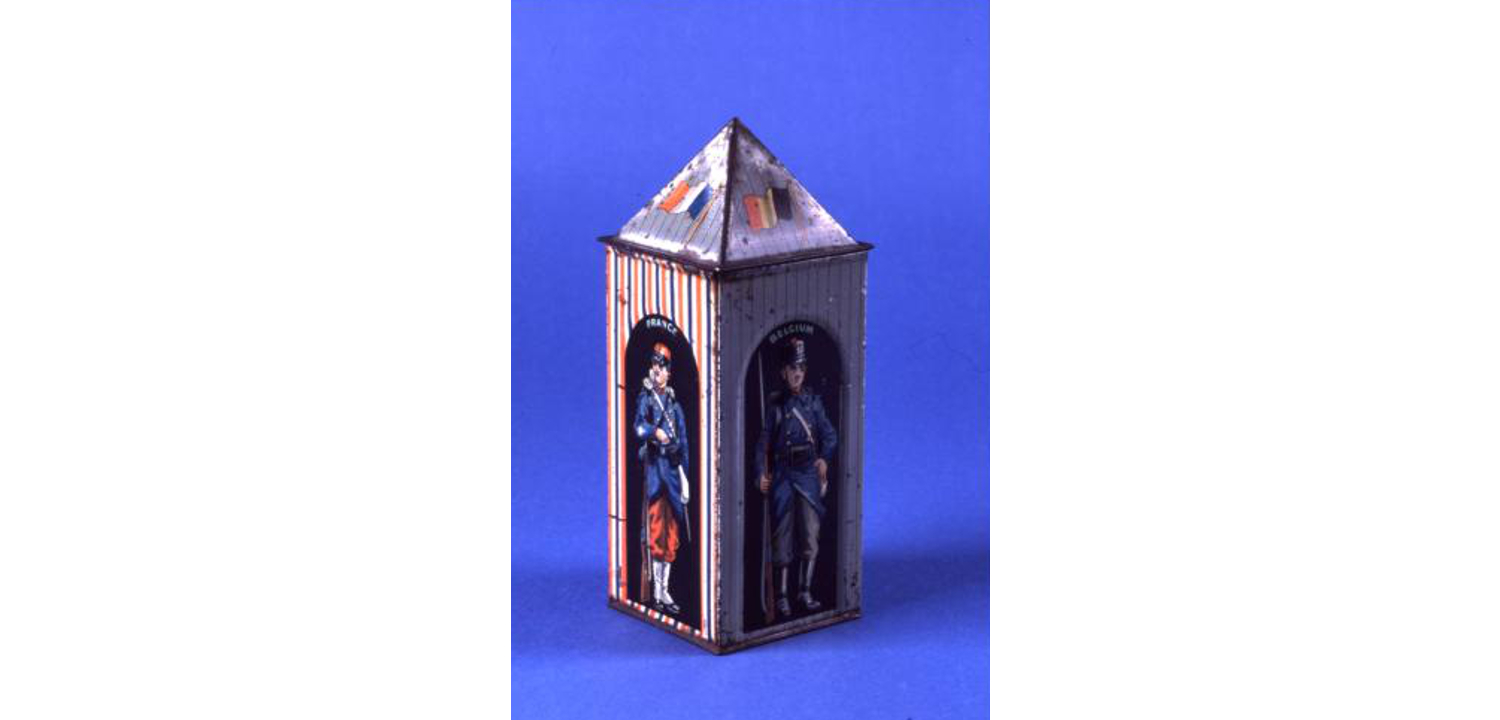
Huntley & Palmers Sentry tin, 1914
6. Between the wars
After the First World War biscuit and tin production returned to pre-war levels. One of the main developments in this period was the production of tins to be used as children's toys; there had been a few made in the Edwardian period, but, with Germanys' economy in ruins, toy imports had dried up. This tin was sold with Melody Mix biscuits and the lid is the top of the pram.
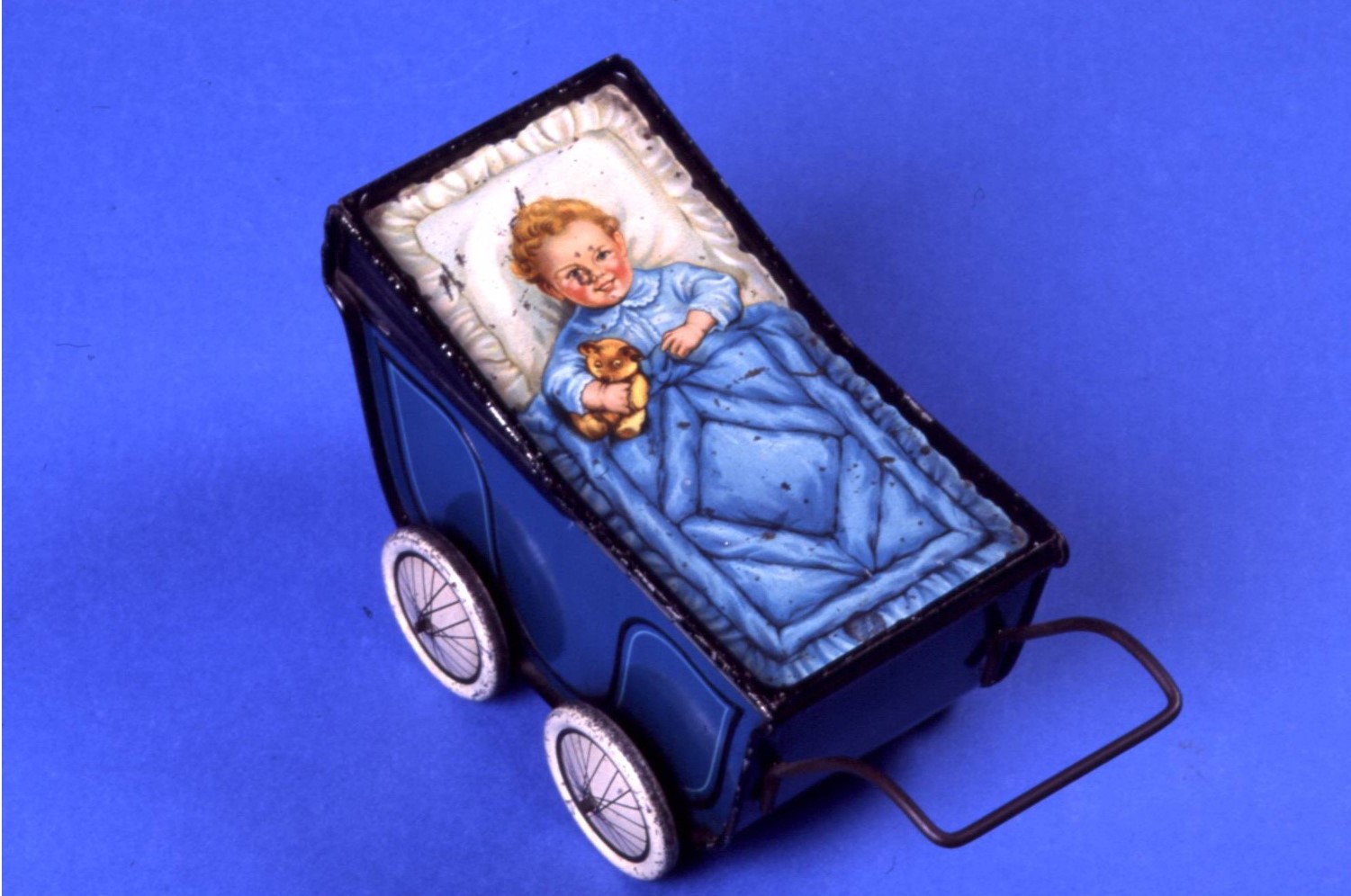
Perambulator tin, 1930
7. Royalty
From the mid 19th century Huntley & Palmers realised that an association with royalty was a real selling point for consumers. This tin was produced in 1939 to commemorate the royal visit of King George VI and Queen Elizabeth to North America. The family portrait on the lid with the popular young Princesses Elizabeth and Margaret was a reproduction of a photograph by Marcus Adams of Reading. Adams took many informal photographs of the young royal family in the 1930s and 40s.
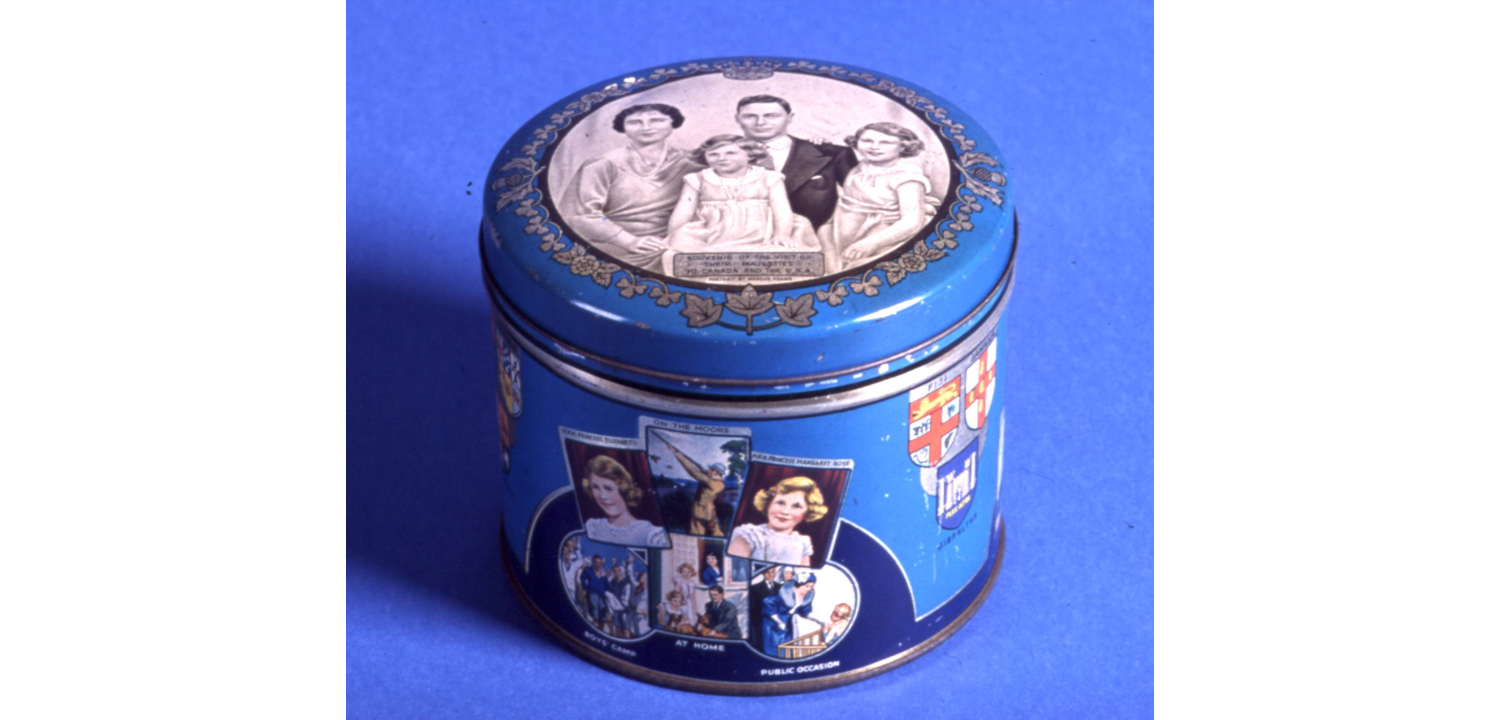
Huntley & Palmers Souvenir tin with Marcus Adams photographs of the royal family, 1939
8. Mid 20th century tins
After the Second World War it was easier for overseas customers to buy Huntley & Palmers’ fancy tins than it was for the British consumers. This was because the government reduced the national debt through increased exports. Tin plate was rationed and alternative materials like aluminum were used.
The Festival of Britain in 1951 promoted modern design and this cocktail tin evokes the growing optimism of the 1950s as life improved for ordinary people after wartime austerity. From the 1950s more photographs began to appear on the tins and for the first time the designs were influenced by television. Cocktail biscuits were popular as were assortments in large square tins.
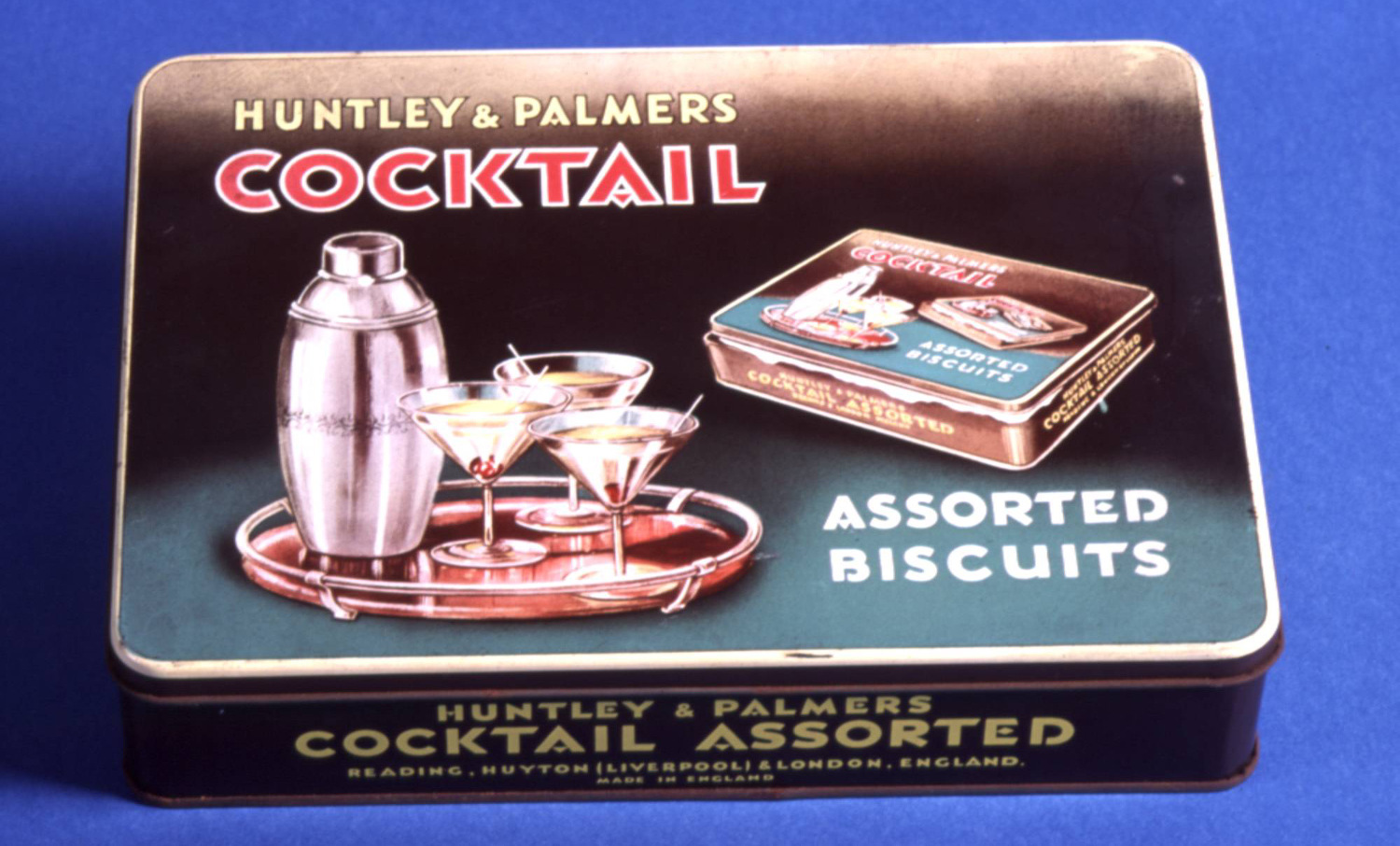
Huntley & Palmers Cocktail Assorted tin, about 1955
9. Wedgwood favourites
Reproduction of Wedgwood designs were a favourite theme Huntley & Palmers tins in the second half of the 20th century. They issued their first Wedgwood tin in 1949 and over the next 30 years they produced over 20 different tins inspired by Wedgwood. This tin from 1976 was made by Huntley, Boorne & Stevens of Reading and is marked 'Design inspired by Josiah Wedgwood and Sons Ltd.' The two cherub figures carrying a third was a popular motif with the tin designers. It was also used on the 'Dark Blue Wedgwood' tin of 1954, the small square 'Cherubs' tin of 1972-1973 and the 'Light Green Wedgwood' tin of 1971-1975.

Huntley & Palmers Wedgwood Casket tin, 1964
10. Naughty, but Nice
By 1960 and 70s the change to paper packaging drastically reduced the number of tins needed by Huntley & Palmers and although many tins were still sold at Christmas, these were mainly of a square or rectangular shape. When biscuit production at Huntley & Palmers factory in Reading ended in 1976, the work for Huntley, Boorne & Stevens severely diminished. In 1985, Huntley, Boorne & Stevens was bought by The Linpac Group and the supply of tins for Huntley & Palmers finally came to an end.
The tin shown below is the most notorious ever issued by Huntley & Palmers. It is called 'Kate Greenaway' after the illustrator who's work inspired this seemingly charming design of an English country garden. However it became the centre of tabloid attention when a vigilant grocer noticed lewd images hidden in the shrubbery. These had been added by a mischievous designer and had gone unnoticed until the tin was already on sale in the shops. Huntley & Palmers quickly withdrew production of the tin although they later capitalised on the publicity by removing the saucy images and reissuing the tin. You can view the tin in the Huntley & Palmers Gallery at Reading Museum.

Huntley & Palmers Kate Greenaway tin, 1980
Discover more
The ten tins shown here are just some of the thousands designed and made in Reading. If your favourite isn’t here you can finds hundreds on display at the Huntley & Palmers Gallery in Reading Museum or browse even more on our collections online website.
You can find biscuit inspired products in our shop and our hands-on leaning team offer a Huntley & Palmers schools session.





